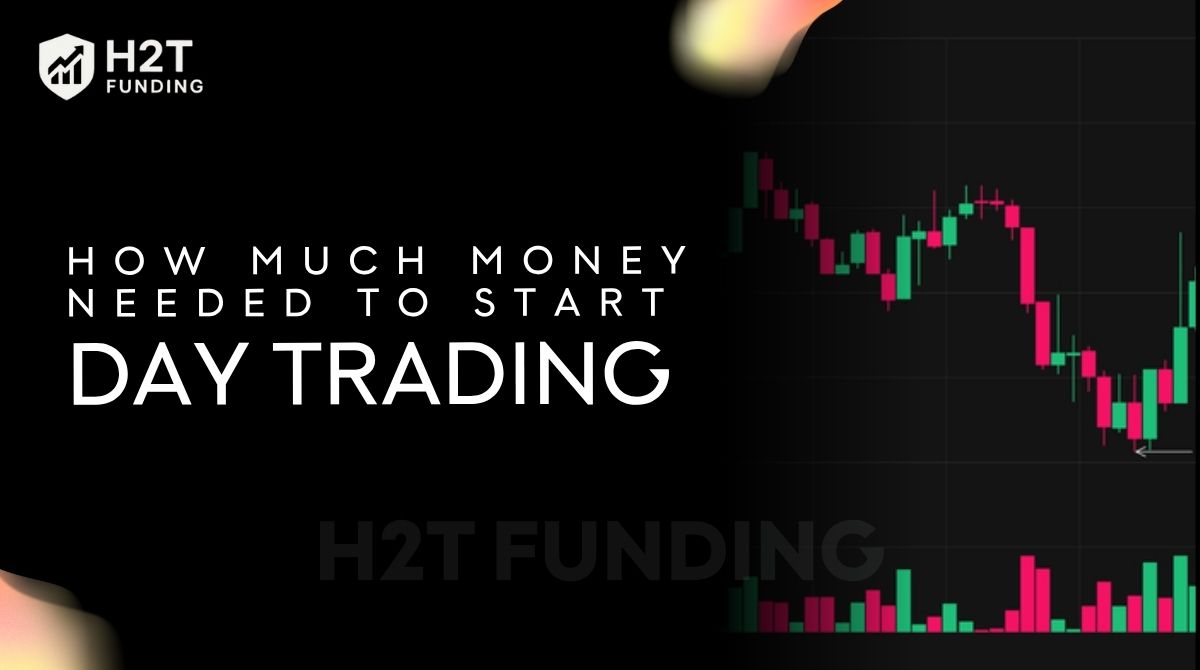How much money needed to start day trading is one of the most common questions every beginner faces. The excitement of turning quick trades into profit often clashes with the fear of losing too much, too soon.
At H2T Funding, we will help you cut through the confusion and approach this question with clarity. Instead of vague promises, this guide will show you exactly what different markets require, from stocks to forex, futures, and crypto.
Key takeaways:
- The amount of capital needed to start day trading depends on the market: stocks, forex, futures, or crypto.
- For U.S. stocks, the pattern day trader rule requires at least $25,000, while forex and crypto accounts can start with a few hundred dollars.
- Costs such as commissions, platforms, and a financial cushion must be considered alongside starting capital.
- Risk management matters more than account size; following the 1–2% rule helps protect against major losses.
- Traders with limited funds can begin with demo accounts or explore funded trading programs before committing large sums.
- Long-term success comes from financial goals, discipline, and consistent learning, not from starting balance alone.
1. Why is it necessary to determine capital before day trading?
Deciding on capital before you place a trade gives you structure, direction, and peace of mind. The first question most traders ask is: How much money do I need to start day trading? It is not just about a number; it is about protecting yourself from mistakes that could drain your account faster than you expect.
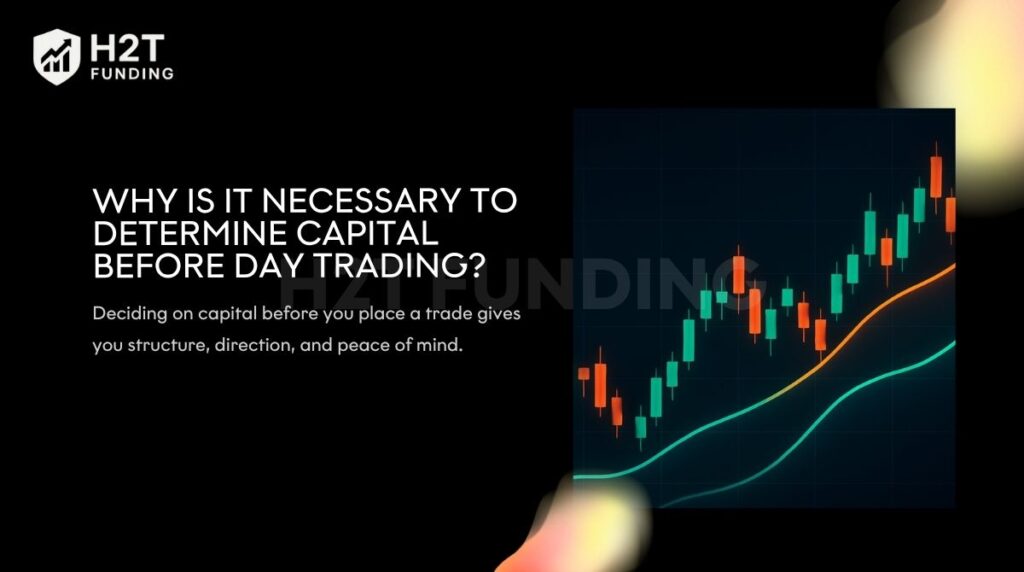
Having clear trading capital helps you shape your risk tolerance and stops you from taking reckless positions.
If you never calculate the minimum amount of money to start day trading, you might overestimate your strength and underestimate potential losses.
A defined balance lets you connect your financial goals with the reality of your brokerage account, avoiding surprises with commissions or transaction fees. I learned early that trading only with money I could lose gave me freedom to focus on strategies, study different trading sessions, and not stress over every tick of market volatility.
In short, understanding how much money you need to start day trading isn’t just about meeting regulatory rules; it’s about building a foundational mindset of discipline.
When I ignored this in my first month, one unexpected loss felt devastating. Once I matched my account size with a smarter approach, my trades became calmer and more consistent.
2. Minimum capital requirements for each market
The core question of how much money is needed to start day trading has a different answer depending on which market you choose.
Each market has its own rules, costs, and risks. Knowing this helps you avoid disappointment and plan your journey with confidence.
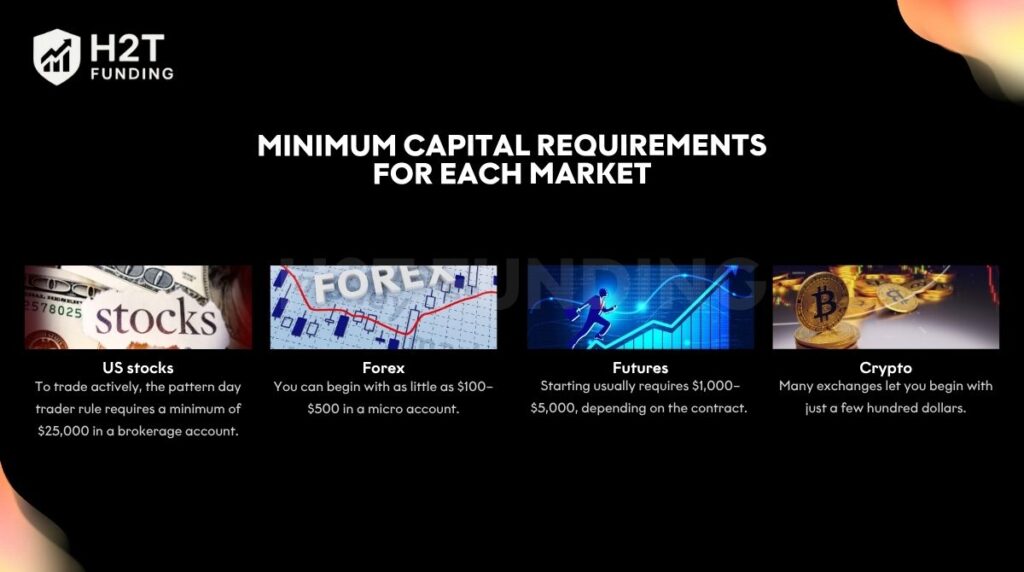
2.1. US stocks
To trade actively, the pattern day trader rule requires a minimum of $25,000 in a brokerage account. Falling under this level means you cannot place more than 3–4 day trades in five business days.
I remember opening my first brokerage account with less than that and being shocked by how limited I was. Traders with less trading capital can use a cash account, but funds settle on a T+2 basis, slowing down activity.
Another option is simply reducing the frequency of trades to stay safe, while also applying a consistency rule in trading to build discipline and better risk management.
2.2. Forex
You can begin with as little as $100–$500 in a micro account. There is no minimum investment set by regulators and no PDT restriction, making it flexible. Still, leverage cuts both ways.
I had a bitter experience with forex early on: I turned $300 into $600 in one week by catching a major news-driven wave.
That excitement led to reckless trading the very next week, and I lost it all even faster. The lesson was clear: Focus on your risk tolerance and structured risk management, not the thrill of fast gains.
2.3. Futures
Starting usually requires $1,000–$5,000, depending on the contract. Futures avoid the PDT rule and allow constant trading, but margin requirements can rise quickly in volatile periods. Without a financial cushion, one bad move can erase weeks of progress.
2.4. Crypto
Many exchanges let you begin with just a few hundred dollars. With markets open 24/7 and no pattern day trader rule, it is accessible for newcomers. But market volatility is extreme, and transaction fees can pile up fast. I found that crypto taught me discipline the hard way; every careless entry cost me more than I expected.
The minimum amount of money to start day trading depends on your market. Stocks demand $25,000 for freedom, forex and crypto allow smaller starts, and futures require a few thousand.
Deciding how much capital you need to start day trading should reflect your goals, your tolerance for potential losses, and your commitment to learning.
3. How much money needed to start day trading
The simple answer is: how much money do you need to start day trading? It depends on your goals, your market, and your ability to protect yourself from unnecessary risk. Here are the most realistic scenarios.
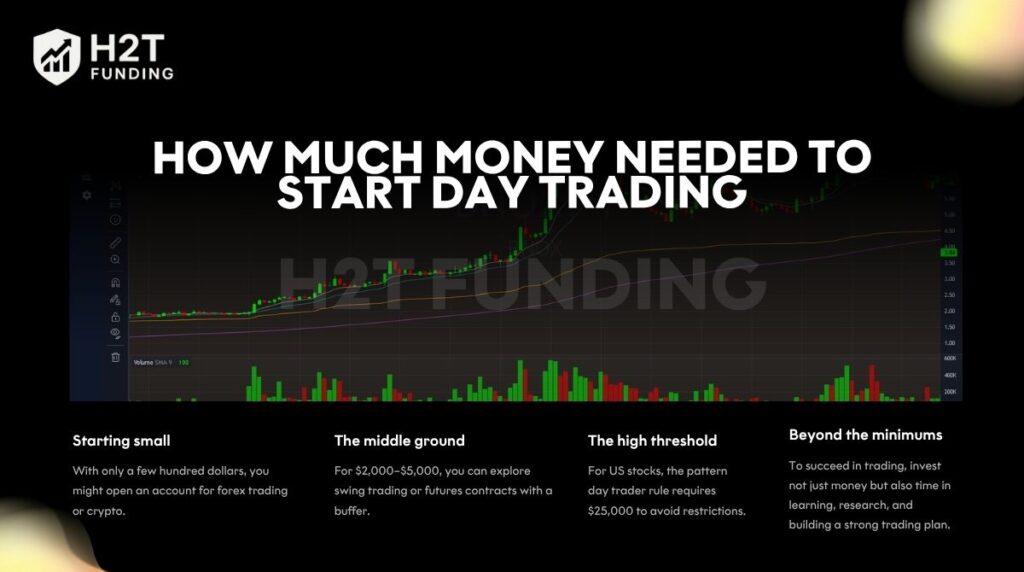
- Starting small: With only a few hundred dollars, you might open an account for forex trading or crypto. It is possible, but trading mistakes come fast and painful if there is no emergency fund to cover losses.
- The middle ground: For $2,000–$5,000, you can explore swing trading or futures contracts with a buffer. This level gives you more trading capital to manage position sizes and align with financial goals. I once began with $3,000 and quickly realised that without trading discipline, even that amount vanished quickly than I thought.
- The high threshold: For US stocks, the pattern day trader rule requires $25,000 to avoid restrictions. Having this level of discretionary income means you can focus more on trading psychology and less on the fear of being sidelined after a few trades.
- Beyond the minimums: To reach trading success, you must invest not only money but also time in educational resources such as financial literacy tips for beginners, market data subscriptions, and building a solid trading plan.
The real answer to how much money I should start day trading with depends on your experience, learning mindset, and commitment to staying in the game.
4. Costs incurred when starting day trading
The truth is that starting out is not only about account size. Even before a trade is placed, real expenses show up, and they can shape your results. Ignoring them is a mistake that makes trading feel more painful than it needs to be.
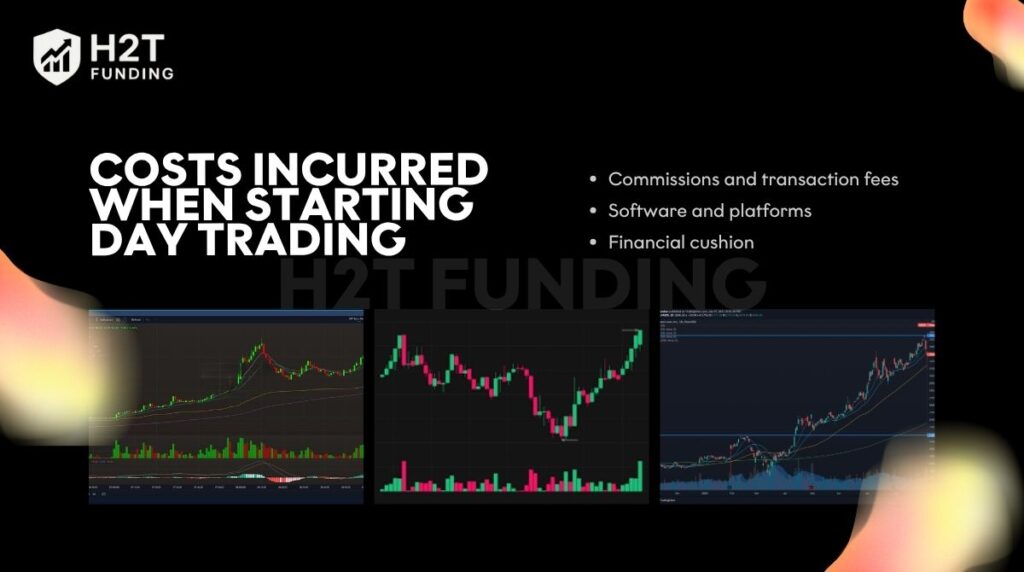
- Commissions and transaction fees: Every trade has a cost. Even if a broker advertises “zero commission,” hidden spreads and small charges eat into results. I once thought a few cents per trade didn’t matter, but after a month of active sessions, the total shocked me.
- Software and platforms: Reliable tools are not free. Charting systems, data feeds, or premium platforms demand a monthly bill. Skipping them might save money at first, but trading blind usually costs far more in losses.
- Financial cushion: Beyond your account balance, there should be money set aside as a buffer. Without it, every setback or significant drawdown feels like the end. I learned that having a small reserve outside my trading account gave me the freedom to stick to my rules instead of chasing losses.
The costs of starting day trading go beyond the trades themselves. From commissions to platforms and the safety of a financial cushion, these hidden demands can be the difference between quitting early and staying long enough to improve.
5. Factors influencing the amount of capital needed
The question of how much to fund an account cannot be answered with a single number. Different traders bring different circumstances, and those circumstances define the capital that makes sense.
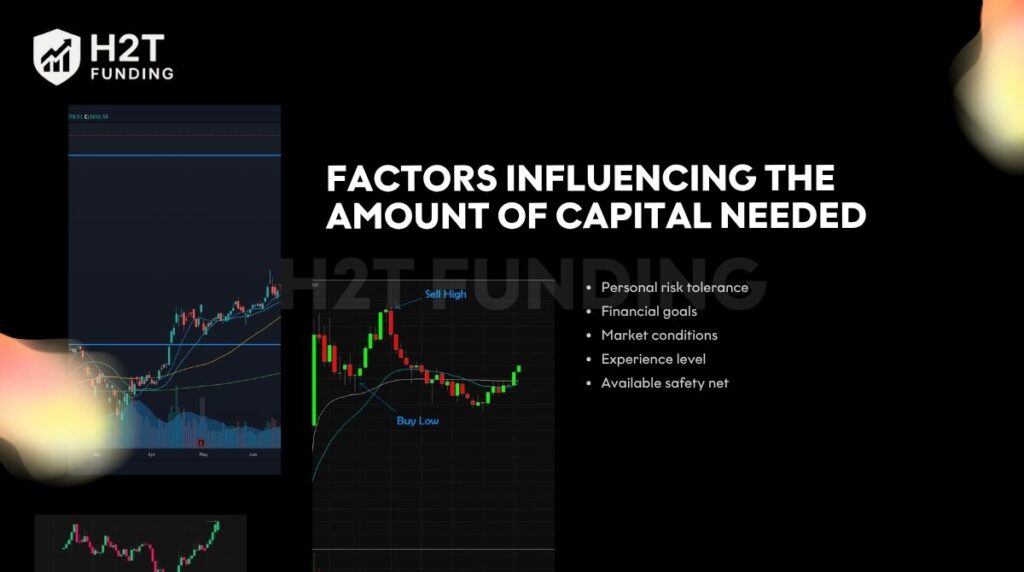
- Personal risk tolerance: Some people can handle watching their account swing without panic, others cannot. I discovered my limit after losing 10% in a single day; it hurt so much that I knew I had started too big.
- Financial goals: A trader who only wants experience needs less than someone aiming to replace a salary. Goals change the level of trading capital required, and they should be clear before the first trade is placed.
- Market conditions: Highly active environments, where tools like option block trades can highlight unusual activity, demand more margin, and wider stops.
- Experience level: Newcomers spend a lot on what feels like market tuition. Learning how to backtest a trading strategy can reduce costly mistakes, though errors are still unavoidable at the start. Smaller amounts may be wiser until confidence and skill grow.
- Available safety net: Having a financial cushion outside trading reduces pressure. Without it, I found myself breaking rules just to recover quickly, which only dug the hole deeper.
The amount of capital needed depends on risk tolerance, financial goals, market volatility, trading experience, and the presence of a cushion to soften losses.
If you are still asking yourself how much you need to start day trading, the answer lies in matching these factors with your personal situation. That is what keeps trading sustainable instead of overwhelming.
6. How much capital is ideal to start with?
A common question is: What is the ideal balance of how much money is needed to day trade without being crushed by pressure? The answer depends on both the market you choose and the vision you carry for yourself.
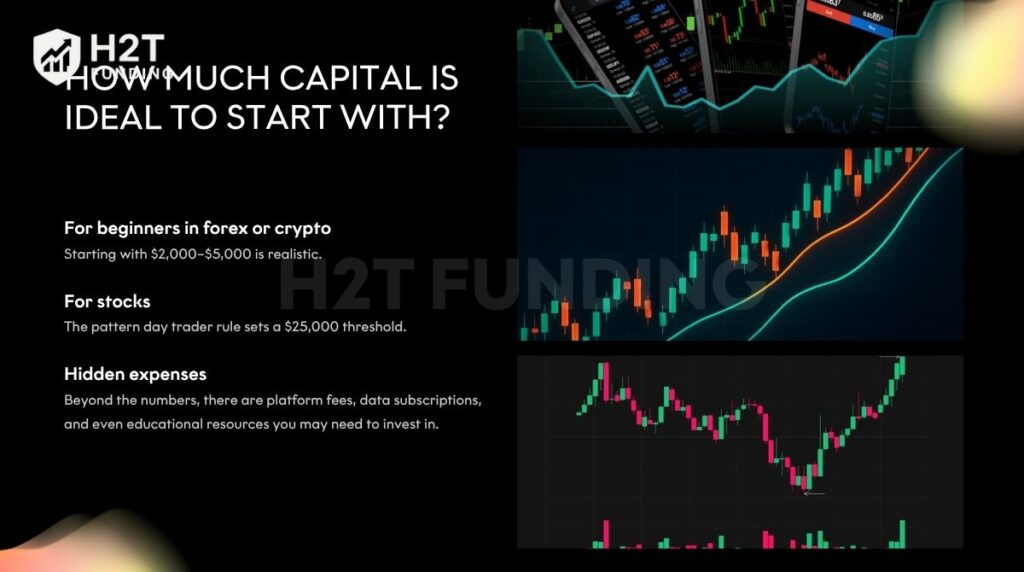
- For beginners in forex or crypto: Starting with $2,000–$5,000 is realistic. This amount of trading capital is large enough to manage position sizes responsibly but small enough to protect against devastating losses. I learned that with this range, mistakes became lessons instead of disasters.
- For stocks: The pattern day trader rule sets a $25,000 threshold. Anything lower leaves you restricted. Reaching this level gives freedom to execute trades without worrying about the next limit, though it also demands clear financial goals and strong self-control.
- Hidden expenses: Beyond the numbers, there are platform fees, data subscriptions, and even educational resources you may need to invest in. Skipping them might save money today, but can delay progress tomorrow.
The ideal starting capital is not a fixed figure. It balances account size with goals, acknowledges the rules of the market, and leaves room for growth. Enough money lets you learn safely while staying long enough to improve.
7. Risk management with different capital
The size of your account changes how you manage each trade. Without a plan, even a well-funded balance can disappear faster than expected.
- The 1–2% rule: Limiting each trade to no more than 1–2% of total capital creates a safety net. It might sound slow, but small risks are what keep you alive long enough to learn.
- Example with $1,000: Risking 2% means $20 per trade. At first, I thought this was too little, yet those controlled losses helped me recover when my setups finally worked.
- The danger of overleveraging: Using too much margin for quick profits is tempting, but it’s the fastest way to drain an account. I once doubled my position size to “make back” losses, only to watch the market take twice as much.
Risk management adapts to capital. Whether the account holds $1,000 or $25,000, survival depends on respecting limits, controlling exposure, and resisting the urge to overreach. Discipline in sizing trades is what separates progress from collapse.
View more:
8. What if there is not enough capital?
Not every trader begins with thousands of dollars. Limited funds don’t mean the end of the journey; they just shape how you should start.
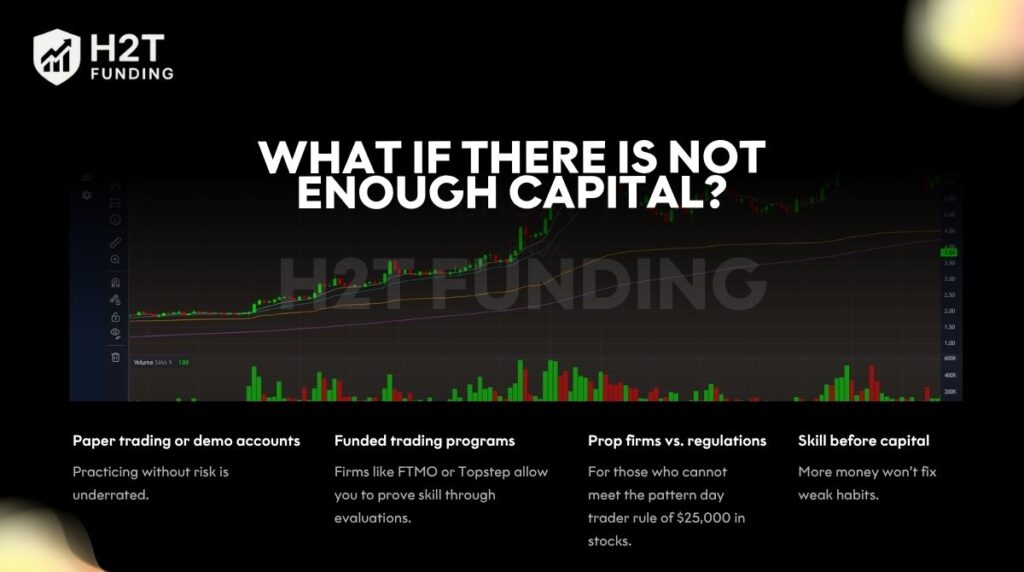
- Paper trading or demo accounts: Practising without risk is underrated. I once spent months on a demo before touching real money, and those habits saved me later.
- Funded trading programs: Learning how to get a funded trading account is a smart option. Firms like FTMO or Topstep allow you to prove your skill through evaluations. Passing gives access to larger balances without risking personal savings. It feels different trading with firm money, but the discipline required is exactly what builds growth.
- Prop firms vs. regulations: For those who cannot meet the pattern day trader rule of $25,000 in stocks, prop firms and how they make money provide a practical alternative. They open the door for active trading without such restrictions.
- Skill before capital: More money won’t fix weak habits. Learning strategy, patience, and emotional control cost nothing but pay back endlessly. I learned that rushing in with a small account felt like burning fuel too fast. Slowing down gave me space to improve.
Lack of capital is not a barrier; it’s a signal to train smarter. Demo trading, funded accounts, and skill-building provide a path forward until the account grows enough to handle risk.
9. Tips to start day trading with limited capital
Having only a small balance does not mean trading is impossible. It means you must move more slowly, protect yourself more, and learn in ways that cost less.
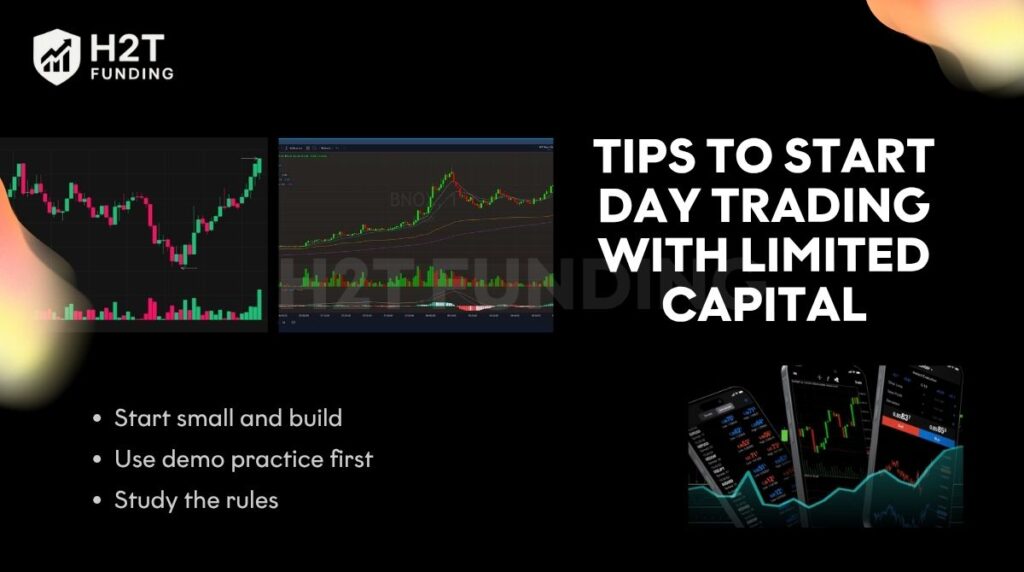
- Start small and build: Understanding how much a day trader can make helps set realistic expectations. Beginning with a modest account kept my losses manageable. Each lesson felt expensive enough to remember but not painful enough to push me out.
- Use demo practice first: Spending time on a demo was humbling. I realised how many errors I made without losing a cent, which gave me confidence before risking real money.
- Study the rules: Every market has guidelines that can catch beginners off guard. I once overlooked settlement times in stocks and ended up stuck for days. Understanding the framework early avoids costly surprises.
With limited capital, patience becomes your edge, and knowing whether you can make a living as a day trader is part of setting smart financial goals. Testing strategies on demo, respecting regulations, and gradually scaling up keeps you alive long enough to grow skills and eventually handle larger accounts.
10. Share from the community
The question of starting capital is not just theory; it’s something thousands of traders wrestle with every day. Reading through community discussions reveals a mix of warnings, encouragement, and raw honesty.
On Quora, one consultant stressed the value of using only a small slice of trading capital per trade. His advice was clear: aim for modest returns, use stop losses, and remember that early on, the real goal is learning. He even illustrated with an example of a trader beginning with Rs. 50,000 and using just 5% per trade to limit damage.
On Reddit, traders debated the $25,000 threshold for US stocks and how the pattern day trader rule limits smaller accounts. Some said futures or forex allow lower starting amounts, while others argued that nothing replaces experience. A few shared stories of starting with $400 or $300 and slowly growing, while others admitted to blowing up accounts until discipline set in.
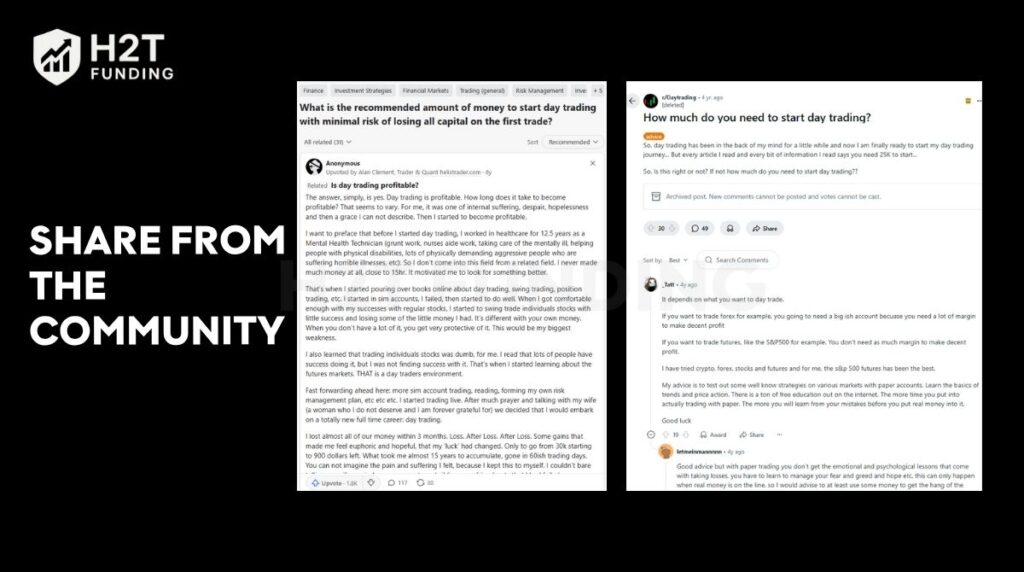
Many repeated the same core truth: paper trading builds skills but lacks the emotional lessons of losing real money. One voice said bluntly that everyone pays market tuition in some way, whether through demo practice or actual losses.
The community agrees there is no single figure that guarantees success. Some recommend $25,000 to avoid limits, others suggest starting with just what you can afford to lose. The unifying theme is caution, patience, and using the early days to learn instead of chasing fast profits.
Read more:
11. FAQs
Yes, but it is very challenging. With such a small account, each mistake feels bigger, and transaction costs take a heavy toll. Many traders treat this as tuition rather than a path to quick profits.
In the U.S., the pattern day trader rule requires a $25,000 minimum balance to place unlimited intraday trades in a margin account. This is designed to protect retail traders from overtrading.
Forex or crypto often works best. They allow entry with a few hundred dollars and do not impose strict capital rules, but volatility and leverage make risk management critical.
Many begin with at least tens of thousands of dollars. Some even save for years before going full-time. Starting with a large cushion reduces pressure and improves survival chances.
Yes, but the odds are tough. Small accounts leave little room for error, and even skilled traders often struggle without enough cushion to absorb losses.
Your ability to day trade stocks will be restricted. You may only make three trades in five business days unless you restore your balance above the threshold.
No. Borrowing magnifies both gains and losses. Most traders regret it because the pressure to repay can push them into reckless decisions.
Technically, yes, usually in crypto or micro forex accounts. But with such a small balance, profits are tiny, and one bad trade can wipe you out.
Yes, though the challenges are similar to those of $100 accounts. It works for learning basics, but is unlikely to provide meaningful returns.
It’s a risk management strategy where you: limit risk to 3% of capital per trade, keep total risk across all open positions under 5%, and target a 7:1 profit-to-loss ratio.
12. Conclusion
There is no single golden figure for how much money needed to start day trading. The right number depends on the market, personal goals, and how much risk you can truly accept without losing sleep.
The best way forward is simple: begin with a demo, step into small trades, and scale up slowly as confidence and consistency grow. Explore more in our Prop Firm & Trading Strategies category of H2T Funding to take your next step with clarity.

